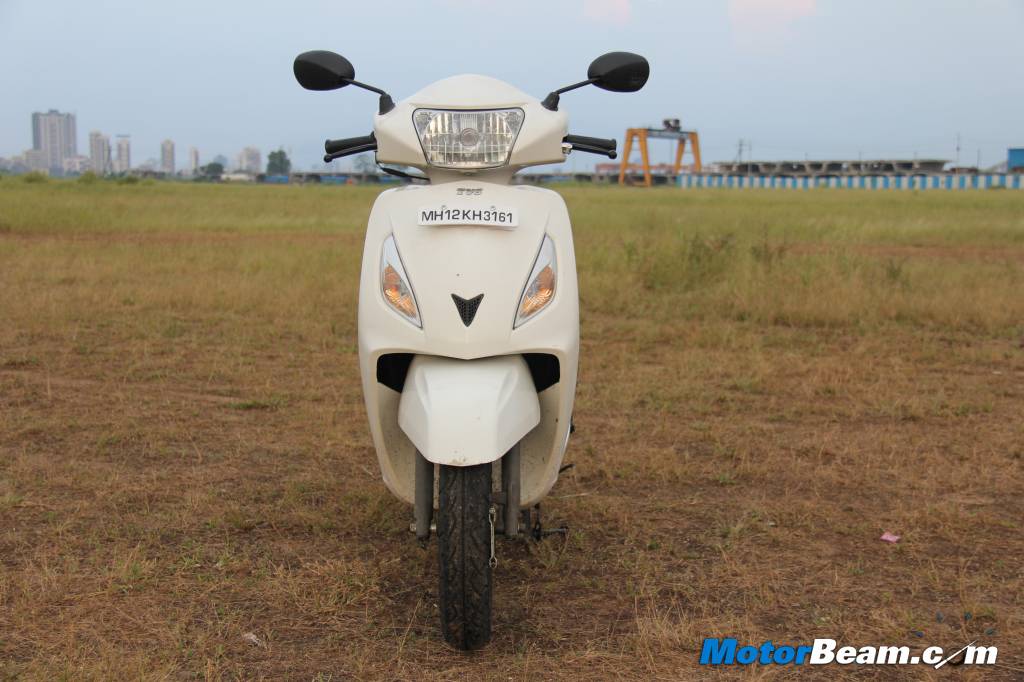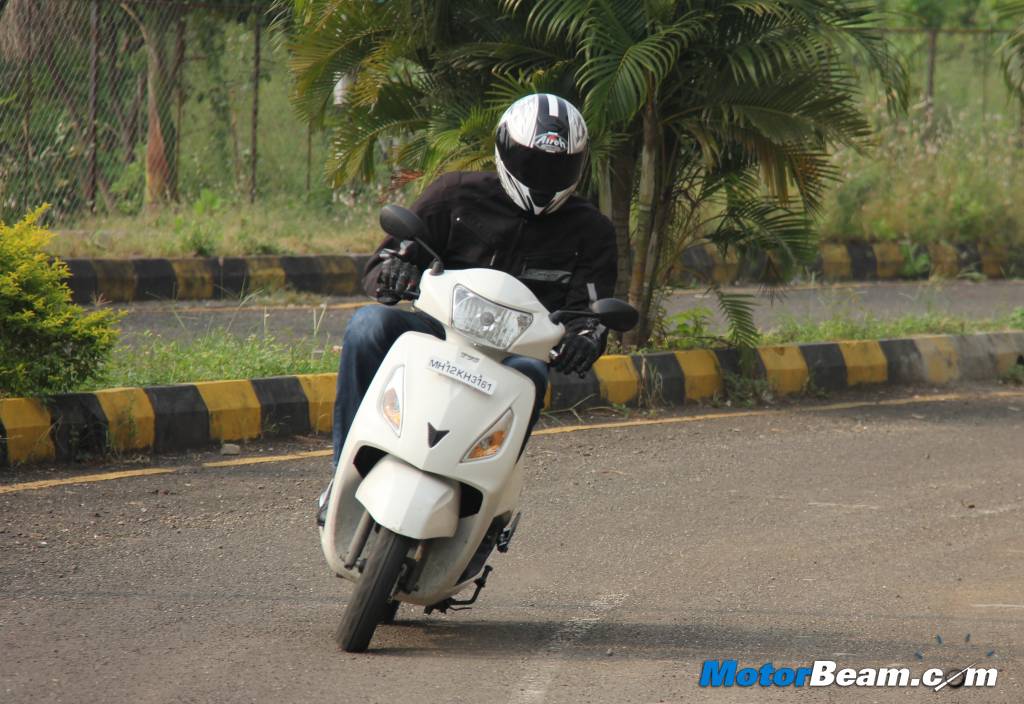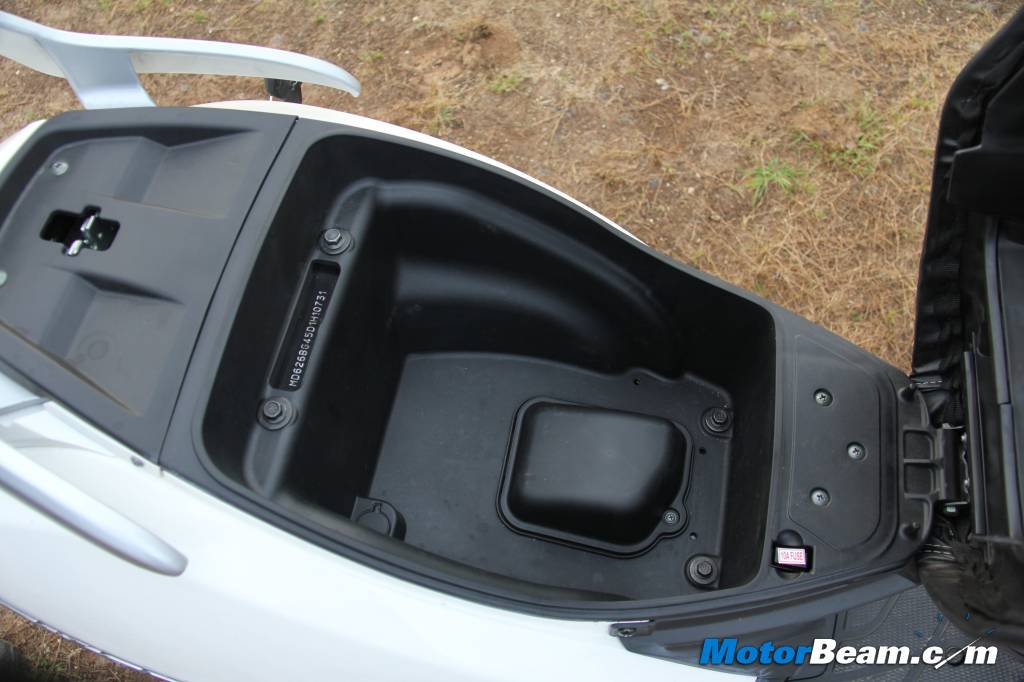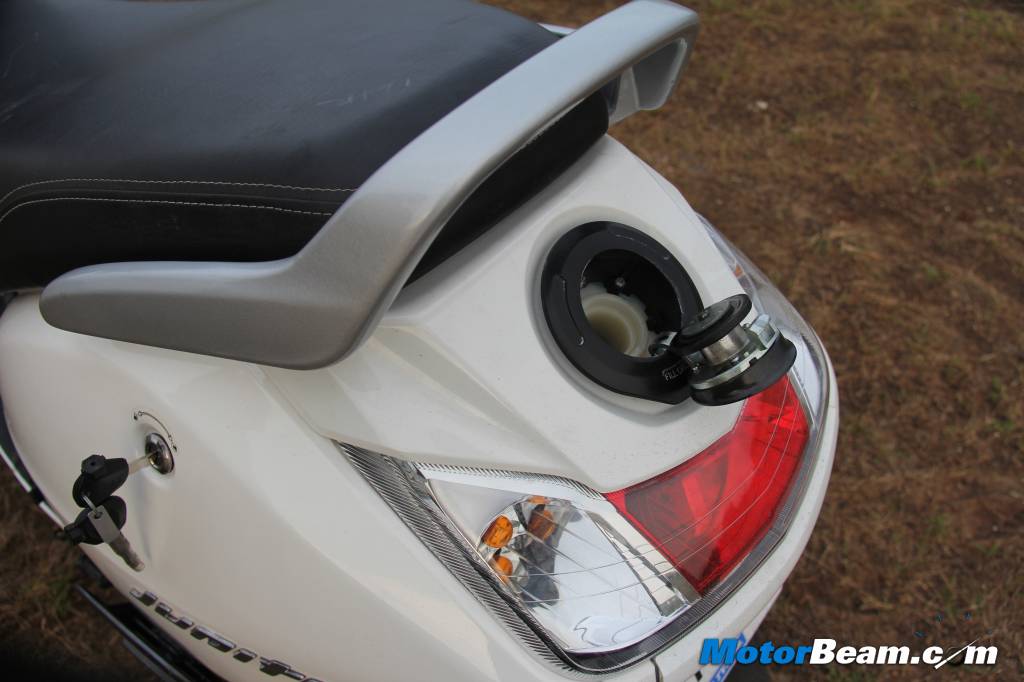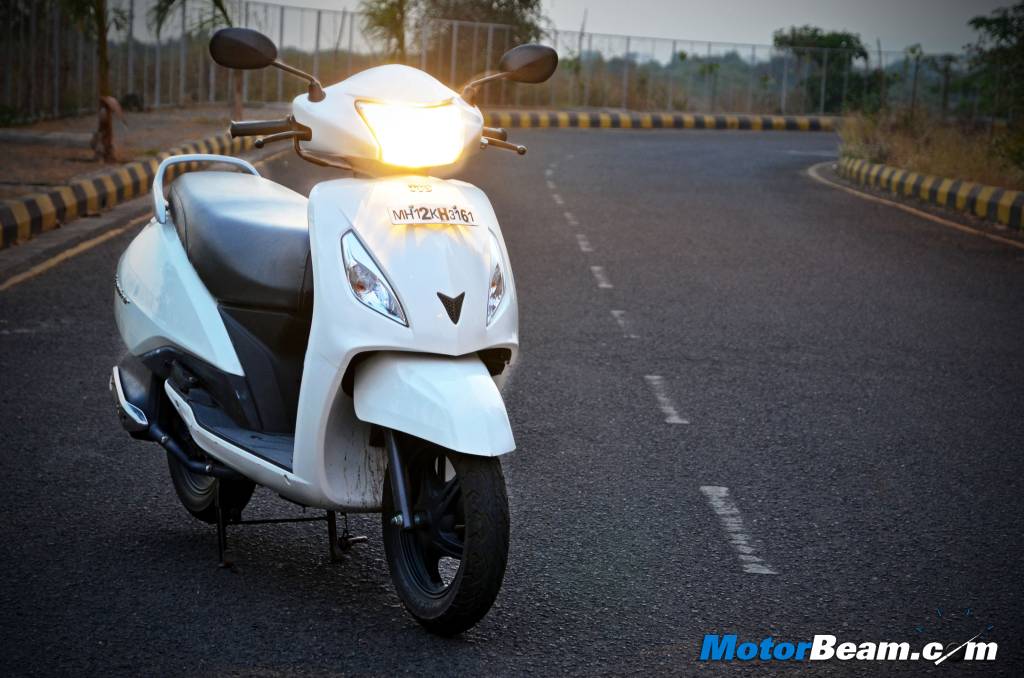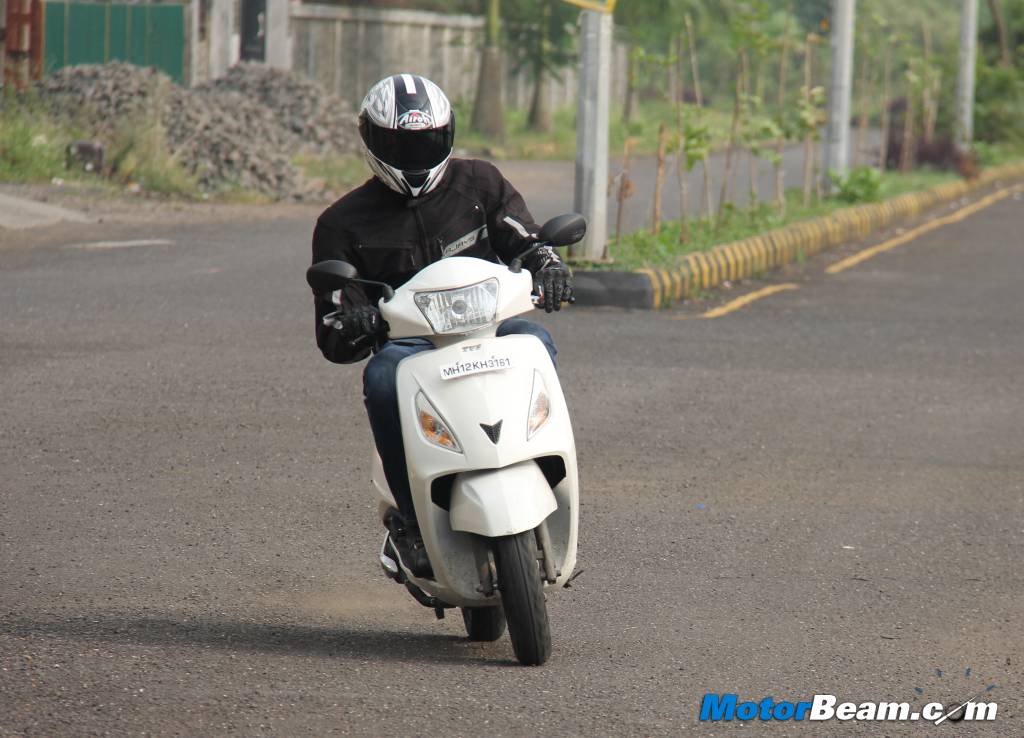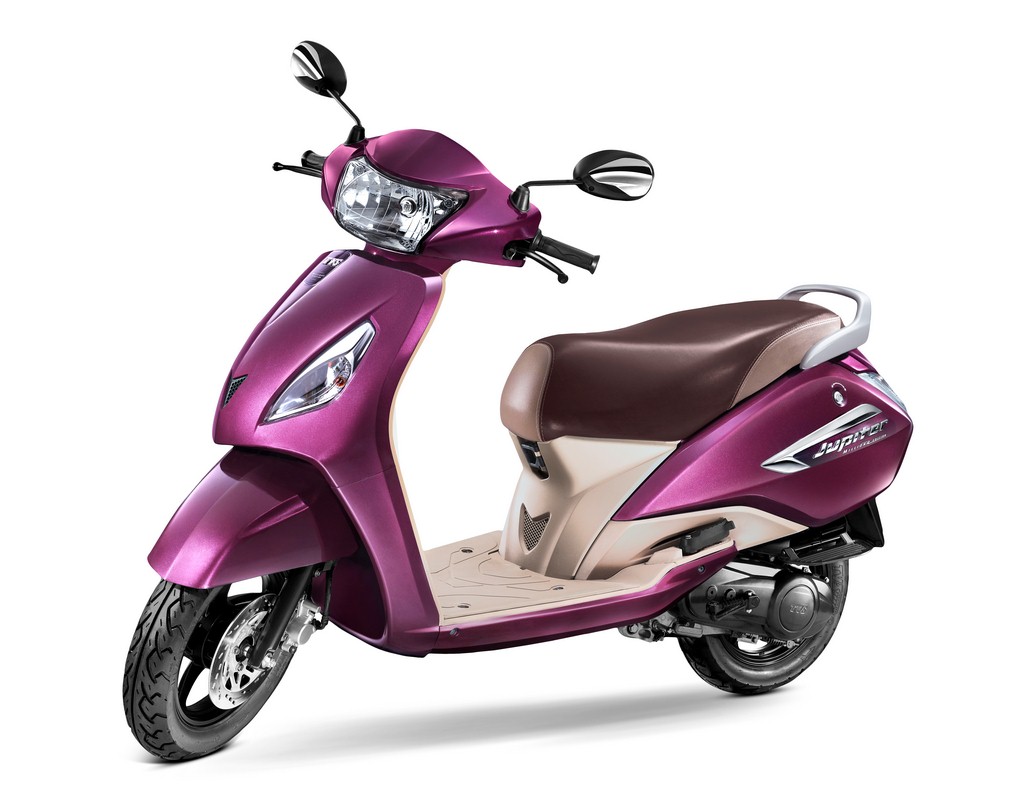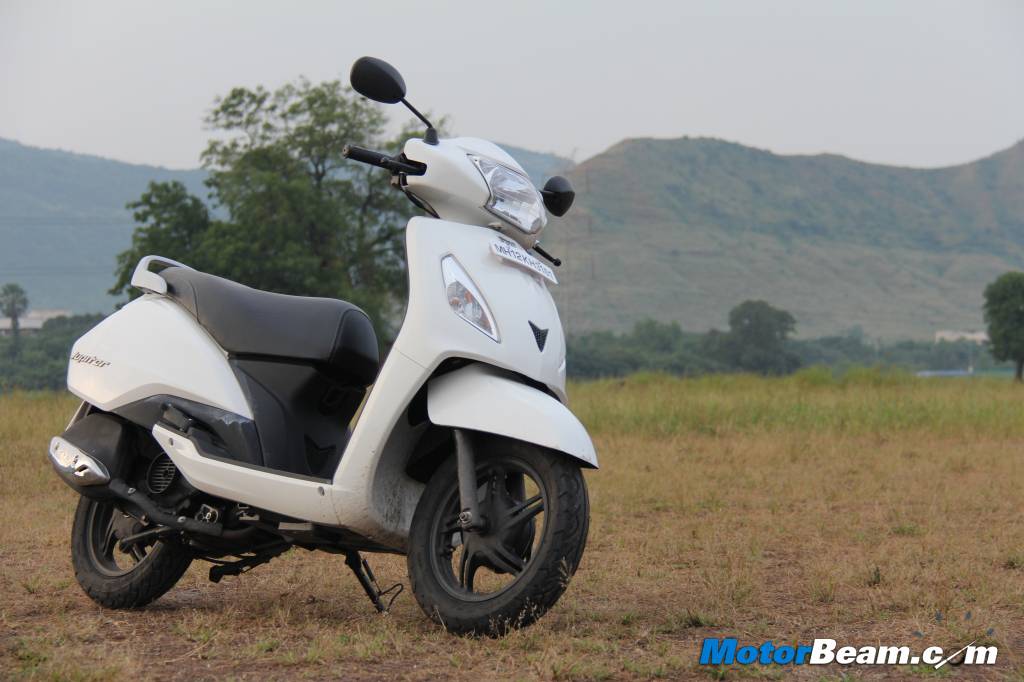
TVS Jupiter Review
Bike Tested: 2013 TVS Jupiter
Price OTR Mumbai: Rs. 52,200/-
The Jupiter comes to Earth and redefines value for humans.
TVS is well known for coming with products which are good on quality and have class leading attention to detail and let’s not forget sheer value, just like its rival. However the pace at which products are rolled out are so slow that they give the market position to international companies within a very short span of time due to this strategy. Motorcycles or scooters, not all offerings are making an impact, which the company seeks. Perhaps it does not have the enormous amount of two-wheelers in any segment that rivals offer in same segments, which seems to be the mantra of the top three 2-wheeler manufactures in the country. Anyways, TVS is the only Indian manufacturer who has been making scooters completely on their own. The new offering, Jupiter, has already created a storm when it comes to value. TVS has redefined value when it comes to their latest offering. Our first short stint with the TVS Jupiter certainly left us impressed and after spending some time with the scooter we are ready with our comprehensive review, which should let you decide which scooter to buy much more easily.
Motor Quest: The Jupiter is targeted at male scooter buyers and the company designed the first Scooty in 1994 as a unisex product but later opted to focus on women consumers.
Styling – Yes, the TVS Jupiter looks like the Honda Activa at the front but if you look closely, it will remind you of the Wego but the headlight on the Jupiter seems a lot brawnier and comes with two pilot lamps. There are minute changes to distinguish it apart like the turn indicators are mounted on the panel below, not like the Activa where it is mounted on the top. Coming to the rear, the tail lights are smaller and edgier and it has LEDs in the stop lamp. The side panels are rounded and they are attached to the rear panel, giving it a seamless and different look.
[flickr size=”center” float=”medium”]http://www.flickr.com/photos/motorbeam/10376589384/[/flickr]
The huge 3D logo (Jupiter) adds some character to the styling. The front sleek mudguard with black wheels adds a touch of sportiness to the TVS Jupiter, however the finish on the wheels is not great when you take a closer look. Similarities with the Activa are because of the rear grab rail, which looks the same from a distance in terms of size and aesthetics. The exhaust canister is a boxy unit, which fits in perfectly inside, aiding mass centralisation and is shielded by a stainless steel heat unit.
[flickr size=”center” float=”medium”]http://www.flickr.com/photos/motorbeam/10376605095/[/flickr]
Instrument Cluster and Switch Gear – The console is completely new when compared to the Wego with black colour in the background to add a bit of sportiness to the cluster. Dedicated turn indicators on each side, fuel reserve light and high beam indicator on the top are placed on the instrument cluster. The fuel gauge on the right is accurate which moves faster (when turned on) than the fuel gauge found on other scooters. What we didn’t like on the cluster of the TVS Jupiter are the fonts. The ones on the Wego were great but the ones on the Jupiter are not that appealing. Switchgear is the same as the Wego, except for the pass button, which is integrated with the high beam button, a clever implementation. The red colour for the ignition and yellow for the horn button are special touches carried from the Wego.
[flickr size=”center” float=”medium”]http://www.flickr.com/photos/motorbeam/10376630576/[/flickr]
The new addition to the cluster is the POWER and ECO mode, which is based on throttle response. ECO mode is when you are riding under 50 km/hr. However when you are doing 70 km/hr while being gentle on the throttle, it will still show you in ECO mode. Twist the wrist 100% and it will switch to POWER mode. The change is instant and the ECO and POWER mode lights are always changing which is disconcerting at first. However to the junta it is a subjective issue. USB, which is located under the seat, is an optional extra. There is a dedicated place assigned by TVS, all you need to do is ask your dealer and he will retrofit it for you.
[flickr size=”center” float=”medium”]http://www.flickr.com/photos/motorbeam/10376623346/[/flickr]
Ergonomics – The sitting position on the Jupiter is upright but your hands are slightly inclined downwards (when you notice carefully), which is for better control and feedback. The rearview mirrors are positioned well but the field view behind is not that great for large people. Seat cushioning is truly brilliant, it feels like a sofa and somehow being that soft, it is still comfortable for long rides. The pillion enjoys the same comfort and has a huge ergonomically designed grab rail for holding on to. The pillion will have to stretch their legs on the right side as there is no footrest right below their leg. There is one on the left side, which is huge and is welded to the chassis, which comes as a standard fitment in the Jupiter. However, the stretch on the ride side is not that far fetched as the Honda Dio. Obviously the problem can be solved with a metal crash guard, which is an added accessory and fits around the scooter from the front to the rear.
[flickr size=”center” float=”medium”]http://www.flickr.com/photos/motorbeam/10376803103/[/flickr]
Performance and Gearbox – The Jupiter is powered by a 110cc, all-aluminium engine, churning out 8 PS of power and 8 Nm of torque. Yes, that is right, power is down by .1 PS compared to the Wego and this is the reason why TVS is using KW (5.88) to mention the power rating. Weight is up by 4 kgs too. So has the brisk nature of the Wego, in terms of performance gone? CVT ratios have been tweaked and the gearbox is much more polished to deliver more low and mid-end torque. Jupiter’s performance will feel much more accessible to newbies and one can feel that engine power is well used, so the answer is no, thanks to subtle changes the brisk nature has not gone.
[flickr size=”center” float=”medium”]http://www.flickr.com/photos/motorbeam/10377921923/[/flickr]
Changes made to the engine include spark plug gap increase, compression ratio increase and reduced friction. All these changes have made the engine behaviour linear. However, since the engine is based on the Wego, there is a of bit throatiness left and throttle response is crisp and the engine has not lost 100% of the fun. Tons of low and mid-end help the Jupiter reach 85 km/hr once you open the throttle 100% on an open road, it reaches so quickly that you tend to back off once you see the speedometer. In city, power is always on tap and when you find a long gap to close, the scooter shoots forward, no heart thumping performance, don’t worry, its only 8 PS after all. Like the Wego, we could only see a speedo indicated top speed of 85 km/hr. We recorded a fuel economy of 47 km/l in the city.
Riding Dynamics – Riding on the same platform as the Wego, the Jupiter uses the same chassis, wheels and tyres. This means telescopic front suspension and 12-inch wheels. The added four kgs of weight and softer dampers have made the ride quality slightly better than the already mature riding Wego. Dynamics are still excellent and the TVS Jupiter is fun to throw around corners and sweepers. It remains poised and well balanced.
[flickr size=”center” float=”medium”]http://www.flickr.com/photos/motorbeam/10376797113/[/flickr]
The only spoilsport is the tyres. Screeching every time on hard braking and not so confidence inspiring in the wet makes it feel like a party with sadistic music. Manoeuvrability in the city is hassle free and u-turn radius is short. We found the scooter to be slightly bumpy on bad roads and when doing high speeds (although changing the tyre pressure resulted in better behaviour). Stopping power on the Jupiter is good. As always, the front brakes are not that great and the rear brake does 90% of the job.
Miscellaneous – The Jupiter comes with a lot of convenient features as standard. External fuel filler cap is a good thing on paper but you have to get down to open it up. So really, it does not make much sense. 17-litres of under-seat storage is plenty full, still it won’t fit a full size sporty helmet. However, most people have half face or smaller helmets which fit in just fine. After fitting a helmet, it can store tit-bits too. Two hooks are present; one at the top and one below the seat. The hook below the seat won’t do daily duties as it not ergonomically placed as the Honda Activa and the hook is a plastic one, not metal. However, the top mounted retractable hook is handy to carry a lot of stuff.
[flickr size=”center” float=”medium”]http://www.flickr.com/photos/motorbeam/10376589394/[/flickr]
Tubeless tyres are great but if you can’t find it in any shop near you when it’s time to replace, you feel disheartened. Come on companies, allow tyre dealers to stock them too. Patented easy to use centre stand works brilliantly, 10% effort required, ladies will love it. Headlight illumination is top notch but the spread, as with scooters is limited as always. Paint quality is good. Panel gaps are not visible but there are some places where finishing is not up to the mark when you look carefully. The Jupiter comes with side indicator buzzers. This is an option we usually see on commuter motorcycles. Nevertheless, this accessory comes as a standard fitment on the Jupiter. The Jupiter also comes with a shutter lock to prevent theft of the scooter with a key. On top of the key there is small hole which lets you close the key hole which can only be opened up with the original key. This feature is found on almost every scooter in the market today.
[flickr size=”center” float=”medium”]http://www.flickr.com/photos/motorbeam/10377921793/[/flickr]
Verdict – The Jupiter comes loaded to the gills with tubeless tyres, fuel reserve light, optional USB charger, parking lamps and LED tail lights. It has a modern suspension, fun to ride efficient engine with great dynamics and all this comes at a value for money price tag which makes it seriously easy for scooter buyers out there to choose from. The Jupiter under cuts the market leader by a decent margin while offering more equipment. The TVS Jupiter is no doubt the ultimate choice in the entire scooter market right now. Looking for a scooter? Buy yourself this planet, ahem scooter.
The TVS Jupiter comes across as a very good package in the scooter segment, offering practicality and performance at an attractive price.
[flickr size=”center” float=”medium”]http://www.flickr.com/photos/motorbeam/10376627306/[/flickr]
What’s Cool
* Dynamics
* Value for money
* Convenient features
What’s Not So Cool
* Below average grip from TVS tyres
* No space for full faced helmet
[flickr size=”center” float=”medium”]http://www.flickr.com/photos/motorbeam/10376605185/[/flickr]
2013 TVS Jupiter Specifications
* Engine: 109.7cc, single-cylinder, air-cooled
* Power: 8 PS @ 7500 RPM
* Torque: 8 Nm @ 5500 RPM
* Transmission: CVT
* 0 – 60 km/hr: 7.2 seconds
* Top Speed: 85 km/hr
* Fuel Consumption: 45-50 km/l
* Fuel Type: Petrol
* Suspension: Telescopic Forks (Front), Hydraulic Gas Filled (Rear)
* Tyres: 90/90/12
* Brakes: 130 mm Drum (Front), 130 mm Drum (Rear)
2013 TVS Jupiter Dimensions
* Length x Width x Height: 1834 mm x 650 mm x 1115 mm
* Wheelbase: 1275 mm
* Seat Height: 765 mm
* Ground Clearance: 150 mm
* Fuel Tank Capacity: 5-litres
* Kerb weight: 112 kgs
Further Reading –
TVS Jupiter Video Review
TVS Jupiter vs Honda Activa vs Yamaha Ray


